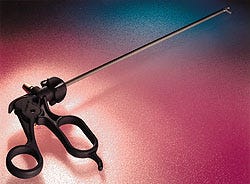Laparoscopic Surgery Improved with Monitoring System
March 1, 1998

Laparoscopic Surgery Improved with Monitoring System
Laparoscopic electrosurgery is a combination of two techniques--monopolar electrosurgery and laparoscopy. Monopolar electrosurgery allows surgeons to both cut and coagulate tissue by passing an electrical current through the tissue mass. The current produces heat that cuts tissue at above 100°C and dries the tissue between 70° and 100°C.
Electrosurgery is frequently used in combination with laparoscopy, a minimally invasive form of surgery that allows surgeons to see the operating area on a video monitor. By inserting the laparoscope, a small camera, into an incision, the doctor can manipulate tissue with remote electrosurgical instruments.
Although both electrosurgery and laparoscopy have been used successfully for years, the combination of electrosurgery plus a closed environment creates a potential for patients to be burned outside of the surgical area if there is a malfunction of the electrosurgical equipment.
Despite occurrences of unintended patient burns, laparoscopic electrosurgery is becoming a safer surgical option because of products such as the Active Electrode Monitoring System (AEM) from Electroscope Inc. (Boulder, CO). Consisting of a monitoring device and integrated surgical instruments, the system has all but eliminated the risk of accidentally burning patient tissue outside of the designated surgical area.
Monitoring System Eliminates Potential Complications
During laparoscopic electrosurgery, burns can occur as a result of either insulation failure in the electrosurgical instrument or capacitive coupling. Insulation failure can occur when the insulation is worn away after repeated use or if it is cut by another instrument. When electrical current travels from the electrosurgical generator through a surgical instrument, any imperfection in the insulation can cause the current to exit not only at the end of the electrode, but also at the break in the insulation. Many breaks in insulation are too small to see and therefore pose a serious problem in electrosurgery where the instruments are frequently reused.
Capacitive coupling occurs when the electric field around the active electrode transfers current to tissue or objects in close proximity to the electrode. This type of burn may occur even if the insulation around the electrode is intact. Burns from capacitive coupling may be found in the vicinity of the cannula, a plastic or metal cylinder used to hold the incision open.
Electroscope's AEM system monitors for stray current on the internal conductive shield of the instrument's 35-cm shaft. When a fault is detected, the AEM shuts down the electrosurgical generator, protecting the patient from burns outside the view of the surgeon performing laparoscopy. The system operates on the principle of monitoring the internally shielded laparoscopic instrument and ensures that 100% of the energy is delivered to the patient wirhin the surgeon's view or target site.
Continuing Improvements
Electroscope has refined its monitoring system and surgical instruments. For example, it has developed universal cords that simplify the setup between the monitor and generator. In addition, the company has reengineered several components in its electrosurgical instruments including the 5-mm laparoscopic handle used to hold jaw inserts such as scissors or graspers.
The new handle is injection molded by Upchurch Scientific (Oak Harbor, WA) using PEEK, a high-performance thermoplastic material manufactured by Victrex Inc. (West Chester, PA). According to Electroscope mechanical design engineer Rich Schneider, "We needed a material that could provide strength and rigidity to the handle so that surgeons could squeeze it with a potentially high amount of force and not have it flex or distort excessively. PEEK polymer provides us with a handle that meets these requirements. It also gives the handle enough impact strength to withstand being dropped on the floor or other abuses."
PEEK grade 450G was used. This is a general-purpose grade for injection molding and extrusion. Because up to 3000 V are applied to the handle, the material must have good dielectric strength. This high voltage is also why uniform molding is so important. The grade used has a dielectric strength of 190 kV/cm and a melt point of 644°F. A critical aspect of any surgical device is its ability to be sterilized without severe degradation. The PEEK polymer material enables the handle to resist the extreme heat and moisture of autoclave sterilization.
Schneider says, "You can certainly find other materials that are just as strong as the PEEK polymer. And, you can find other materials that are just as fracture resistant, or that are just as dielectrically strong. However, it was the combination of these properties plus the polymer's sterilizability that gave us what we needed for the handle."
In addition to using PEEK polymer for the handle, Electroscope used it in the redesign of other system components. "We also used the polymer for the index knob that rotates the jaw insert within the handle."
The instrument redesign was concurrently engineered by Electroscope and Upchurch Scientific. "They had the professional expertise to provide valuable input into the design of the part and to mold PEEK polymer the way it should be molded. The handles are smooth, fully crystalline, and consistent in color," Schneider says.
Molder Aids Redesign
From the design and development through validation and production, Upchurch Scientific performed an integral role in the instrument redesign.
In addition, Upchurch Scientific designed, prototyped, and insert molded several stainless-steel parts into the PEEK polymer handle, and this helped decrease cost and ensure electrical insulating properties.
The result of the collaboration, says Schneider, is that "Electroscope now has a handle that is esthetically appealing, resists degradation from repeated sterilization, provides excellent electrical insulation, and has good structural integrity."
For more information on Upchurch Scientific, call 800/426-0191. To learn more about the PEEK polymer, call Victrex at 610/696-3144.
You May Also Like

.png?width=300&auto=webp&quality=80&disable=upscale)
